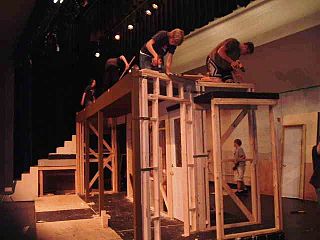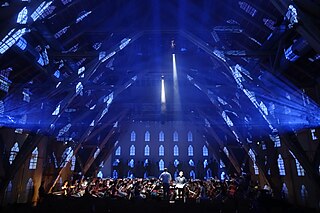Related Research Articles
A film crew is a group of people, hired by a production company, for the purpose of producing a film or motion picture. The crew is distinguished from the cast, as the cast are understood to be the actors who appear in front of the camera or provide voices for characters in the film. The crew is also separate from the producers, as the producers are the ones who own a portion of either the film studio or the film's intellectual property rights. A film crew is divided into different departments, each of which specializes in a specific aspect of the production. Film crew positions have evolved over the years, spurred by technological change, but many traditional jobs date from the early 20th century and are common across jurisdictions and filmmaking cultures.

Stagecraft is a technical aspect of theatrical, film, and video production. It includes constructing and rigging scenery; hanging and focusing of lighting; design and procurement of costumes; make-up; stage management; audio engineering; and procurement of props. Stagecraft is distinct from the wider umbrella term of scenography. Considered a technical rather than an artistic field, it is primarily the practical implementation of a scenic designer's artistic vision.

Theatrical scenery is that which is used as a setting for a theatrical production. Scenery may be just about anything, from a single chair to an elaborately re-created street, no matter how large or how small, whether the item was custom-made or is the genuine item, appropriated for theatrical use.

Theatrical scenic painting includes wide-ranging disciplines, encompassing virtually the entire scope of painting and craft techniques. An experienced scenic painter will have skills in landscape painting, figurative painting, trompe-l'œil, and faux finishing, and be versatile in different media such as acrylic, oil, and tempera paint. The painter might also be accomplished in three-dimensional skills such as sculpting, plasterering and gilding. To select the optimal materials, scenic painters must also have knowledge of paint composition.

Set construction is the process undertaken by a construction manager to build full-scale scenery, as specified by a production designer or art director working in collaboration with the director of a production to create a set for a theatrical, film, or television production. The set designer produces a scale model, scale drawings, paint elevations, and research about props, textures, and so on. Scale drawings typically include a groundplan, elevation, and section of the complete set, as well as more detailed drawings of individual scenic elements which, in theatrical productions, may be static, flown, or built onto scenery wagons. Models and paint elevations are frequently hand-produced, though in recent years, many Production Designers and most commercial theatres have begun producing scale drawings with the aid of computer drafting programs such as AutoCAD or Vectorworks.

Scenic design, also known as stage design or set design, is the creation of scenery for theatrical productions including plays and musicals. The term can also be applied to film and television productions, where it may be referred to as production design. Scenic designers create sets and scenery to support the overall artistic goals of the production. Scenic design is an aspect of scenography, which includes theatrical set design as well as light and sound.
Sound design is the art and practice of creating soundtracks for a variety of needs. It involves specifying, acquiring or creating auditory elements using audio production techniques and tools. It is employed in a variety of disciplines including filmmaking, television production, video game development, theatre, sound recording and reproduction, live performance, sound art, post-production, radio, new media and musical instrument development. Sound design commonly involves performing and editing of previously composed or recorded audio, such as sound effects and dialogue for the purposes of the medium, but it can also involve creating sounds from scratch through synthesizers. A sound designer is one who practices sound design.
In film and television, the production designer is the individual responsible for the overall aesthetic of the story. The production design gives the viewers a sense of the time period, the plot location, and character actions and feelings. Working directly with the director, cinematographer, and producer, production designers have a key creative role in the creation of motion pictures and television. The term production designer was coined by William Cameron Menzies while he was working on the film Gone with the Wind. Production designers are commonly confused with art directors as the roles have similar responsibilities. Production designers decide the visual concept and deal with the many and varied logistics of filmmaking including, schedules, budgets, and staffing. Art directors manage the process of making the visuals, which is done by concept artists, graphic designers, set designers, costume designers, lighting designers, etc. The production designer and the art director lead a team of individuals to assist with the visual component of the film. Depending on the size of the production the rest of the team can include runners, graphic designers, drafts people, props makers, and set builders. Productions Designers create a framework for the visual aesthetic of a project and work in partnership and collaboration with the Set Decorator & Set Decorating department to execute the desired look.
Scenography is a practice of crafting stage environments or atmospheres. In the contemporary English usage, scenography can be defined as the combination of technological and material stagecrafts to represent, enact, and produce a sense of place in performance. While inclusive of the techniques of scenic design and set design, scenography is a holistic approach to the study and practice of all aspects of design in performance.

United Scenic Artists, Local USA 829, formerly known as United Scenic Artists of America (USAA), is an American labor union. It is a nationwide autonomous Local of the International Alliance of Theatrical Stage Employees. It organizes designers, artists, and craftspeople in the entertainment and decorative arts industries. The organization was part of International Brotherhood of Painters and Allied Trades, however it reaffiliated with IATSE in 1999. United Scenic Artists was organized to protect craft standards, working conditions and wages for the entertainment and decorative arts industries.
Television crew positions are derived from those of film crew, but with several differences.
Joseph "Jo" Mielziner was an American theatrical scenic, and lighting designer born in Paris, France. He was described as "the most successful set designer of the Golden era of Broadway", and worked on both stage plays and musicals.

The Art Directors Guild is a labor union and local of the International Alliance of Theatrical and Stage Employees (IATSE) representing 3,278 motion picture and television professionals in the United States and Canada.
A theatrical technician, also known as a theatrical tech, theatre technician, or theatre tech is a person who operates technical equipment and systems in the performing arts and entertainment industry. In contrast to performers, this broad category contains all "unseen" theatrical personnel who practice stagecraft and are responsible for the logistic and production-related aspects of a performance including designers, operators, and supervisors.

Video design or projection design is a creative field of stagecraft. It is concerned with the creation and integration of film, motion graphics and live camera feed into the fields of theatre, opera, dance, fashion shows, concerts and other live events. Video design has only recently gained recognition as a separate creative field. For instance, United Scenic Artists' Local 829, the union representing designers and scenic artists in the US entertainment industry, only added the Global Projection Designer membership category in 2007. Prior to this, the responsibilities of video design would often be taken on by a scenic designer or lighting designer. A person who practices the art of video design is often known as a Video Designer. However, naming conventions vary worldwide, so practitioners may also be credited as Projection Designer, "Media Designer", Cinematographer or Video Director. As a relatively new field of stagecraft, practitioners create their own definitions, rules and techniques.
The following outline is provided as an overview of and topical guide to stagecraft:

Henry Hawes Craven Green was an English theatre scene-painter. He collaborated with Henry Irving, Richard D'Oyly Carte and Herbert Beerbohm Tree, producing stage sets of unprecedented realism. Craven's career lasted from 1853 to 1905, spanning the end of the era of gas lighting in theatres and the beginning of electrical lighting; he developed new techniques to co-ordinate the appearance of theatre settings during the transition from gas to electricity. He was regarded as the finest scene-painter of his day and was the last major scenic designer in the ultra-realistic tradition.
Theatre in the nineteenth century was noted for its changing philosophy, from the Romanticism and Neoclassicism that dominated Europe since the late 18th century, to Realism and Naturalism in the latter half of the 19th century, before it eventually gave way to the rise of Modernism in the 20th century. Scenery in theater at the time closely mirrored these changes and with the onslaught of the Industrial Revolution and technological advancement throughout the century, dramatically changed the aesthetics of the theater.
Theatre in the nineteenth century was noted for its changing philosophy from the Romanticism and Neoclassicism that dominated Europe since the late 18th century to Realism and Naturalism in the latter half of the 19th century before it eventually gave way to the rise of Modernism in the 20th century. Scenery in theater at the time closely mirrored these changes, and with the onset of the Industrial Revolution and technological advancement throughout the century, dramatically changed the aesthetics of the theater.
References
- ↑ Ionazzi, Daniel (1996-10-15). The Stagecraft Handbook . Writer's Digest Books. ISBN 978-1-55870-404-6.
- ↑ Crabtree, Susan; Beudert, Peter (2012-11-12). Scenic Art for the Theatre: History, Tools and Techniques. CRC Press. ISBN 978-1-136-08430-0.